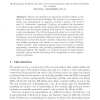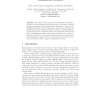47 search results - page 1 / 10 » A Framework for Tubular Organs Segmentation |
WSCG
2004
13 years 5 months ago
2004
Tubular organs (blood vessels and bronchial tubes), because of their anti-compact nature, generally appear randomly cross-sectioned in CT slices. Because of this, it's diffic...
MICCAI
2006
Springer
14 years 5 months ago
2006
Springer
Spinal cord analysis is an important problem relating to the study of various neurological diseases. We present a novel approach to spinal cord segmentation in magnetic resonance i...
CVPR
2006
IEEE
14 years 6 months ago
2006
IEEE
We present a novel approach to the segmentation and analysis of vasculature from volumetric medical image data. Our method is an adoption and significant extension of deformable o...
MICCAI
2005
Springer
14 years 5 months ago
2005
Springer
We present a novel technique for the automatic formation of vascular trees from segmented tubular structures. Our method combines a minimum spanning tree algorithm with a minimizat...
ECCV
2010
Springer
13 years 6 months ago
2010
Springer
Abstract. Image segmentation and figure/ground organization are fundamental steps in visual perception. This paper introduces an algorithm that couples these tasks together in a s...


